Rosheen Kaul's guide to where to eat in Box Hill, Melbourne
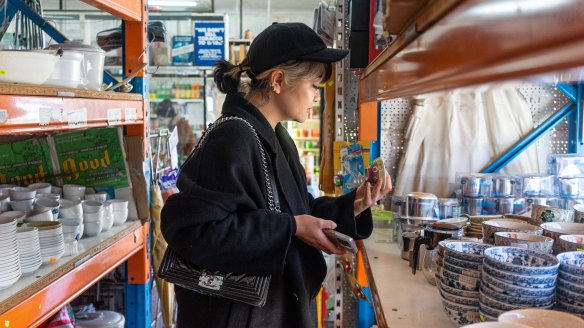
If you follow Melbourne's food scene, you already know Etta head chef Rosheen Kaul. She's been prolific in the media since the July release of Chinese-Ish, the cookbook she co-authored with illustrator Joanna Hu. But there's plenty you don't know about her, too.
Kaul majored in geosciences at Monash University, but found dinosaur digs dull. Her first taste of Uighur cuisine was in China while training with the Australian fencing team. She's also obsessed with Box Hill, a mainly Chinese suburb in Melbourne's east (39 per cent of the population, according to the 2021 census), where I'm waiting for her to arrive in the Box Hill Central food court.
Related Article
She's as apologetic as she is late, a blur of Melbourne black from her oversized coat to her short-brimmed cap. Within minutes she's reminiscing about her childhood visits to Box Hill every Saturday after Chinese school, when she moved from Singapore to Australia in year 3.
"We'd come to Hills BBQ Noodle Shop and my sister, mum and dad would share two plates of chicken, salted fish fried rice and gai laan with garlic, because theirs are perfect iterations of those really simple dishes," she says.
It wasn't until she accompanied her mother on shopping trips when she was a little older that they began to eat in the food court we meet in today.
It's been amazing seeing Box Hill change over the years … all these little regional Chinese cuisine stalls have popped up.
"Honestly, this could just be a guide to Box Hill Central. I love this place," she says.
Kaul leads me from counter to counter, starting at Ms Bean with two fresh soy milks. Across the way is vegan Chinese store Blissful Station. Kaul points to a glutinous rice log stuffed with youtiao (Chinese doughnut) and pickled mustard greens, and we impulse-buy five fried wontons for $6.

"When you eat Chinese vegetarian food, you don't miss meat, because it's got all the textures and seasoning. I would eat it every day if I was vegan," she says.
Back in the main thoroughfare at Rainbow Chicken, we order from the heated display of delicious fried things in piles and on sticks: fried chicken drumsticks and wings, a Taiwanese pork sausage perfumed with rose wine and something shaped like a hockey puck and labelled vegetable burek.
"They call them burek, but they're heaps," says Kaul. "They've got mung bean noodles, scrambled egg and garlic chives inside."
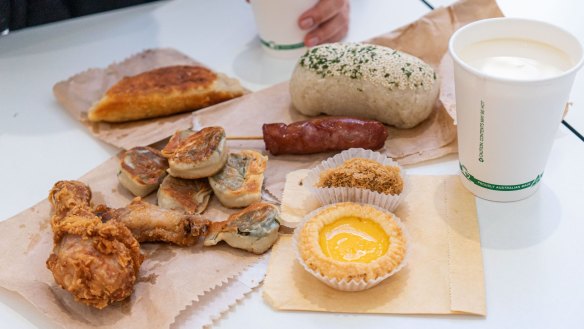
We swap tables to one reserved for Grain Asian Cafe, a Box Hill Central stalwart. It's slowly taking over the food court, having added Grain Asian BBQ and Grain Asian Dessert (Kaul swears by their egg tarts).
The original is known for its yong tau foo, vegetables and tofu stuffed with fish paste. Kaul fastidiously divides the broth and vegetables into two bowls in a manner that reveals she's the younger of two sisters.
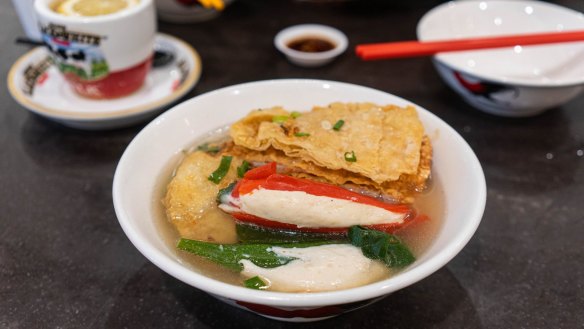
The biggest surprise is Home Souv, which Kaul described to me as "that crazy delicious Chinese kebab salad place".
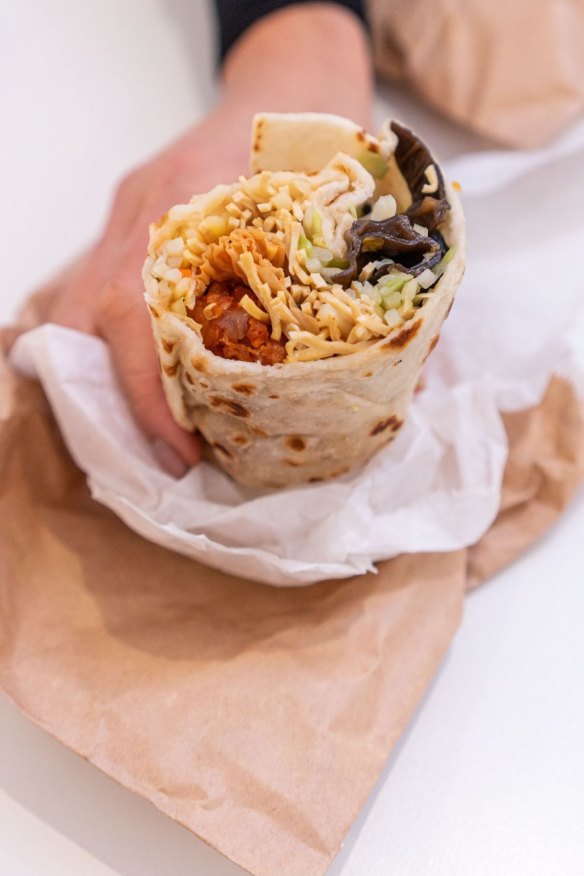
Fillings range from crispy chicken and stir-fried lamb to slow-cooked pork hock and fried, shredded pancake. "Pita" here is thin, brown pastry reminiscent of pancakes at yum cha. I can taste chilli oil and a melange of spices.
"When you go to north-western China, the lines become really blurred with Middle Eastern seasoning. In here there's cumin, coriander, fennel; but when you eat it with the salads you get all those cold textures as well, you know, the QQ textures," says Kaul.
Actually, I don't. Kaul explains QQ, a Taiwanese phenomenon referring to the foods with a chewy, bouncy texture (think mochi, fish cakes and bubble tea pearls). Kaul calls it "bouncy squish-squish".
For a lesson in QQ, we head to Magic Cuisine, also in Box Hill Central, which sells plastic containers filled with cold Chinese salads made with noodles, pickles, bean curd and offal.
"It's been amazing seeing Box Hill change over the years … all these little regional Chinese cuisine stalls have popped up," Kaul says.
She lists some: Shaanxi-Style Restaurant for the spiced lamb and cold noodles, Colourful Yunnan for the myriad foraged mushrooms in the dishes and Old Street Hunan for steamed fish head with pickled chillies and black stinky tofu.
Kaul loves to cook as much as she loves to eat. During lockdown, she published recipes alongside Hu's illustrations in an online project, The Isol(Asian) Cookbook. A publisher from Murdoch took notice and commissioned a printed version, which grew into Chinese-ish, documenting recipes from the Chinese diaspora. It made second place on Readings' best-seller list the week it came out in early July.
"I've never been ashamed of being Asian. My parents raised me to be really proud, but the 'ish' encapsulates everything else that Jo and I are," says Kaul.
The most traditional dish she cooks is cheng tng, a Singaporean dessert soup. She takes me to Fuji Dry Seafood, where she sources the dry ingredients, such as dried white snow fungus and red dates.
Kaul buys pickling jars nearby at Hello Kitchen, but we're distracted by novelty steamers shaped like adorable pigs. We head to another kitchenware store on Station Street called Box Hill Asian Food Centre, where Kaul vouches for a dangerously sharp hand-held mandolin and an $8.50 Vietnamese paperless coffee filter that she travels with.
Just down the road at Victoria Quality Butcher, we're eyeing off Korean-branded silkworm pupa in cans and flawless Styrofoam packs of pre-sliced wagyu when Kaul drops a bomb: "You know I've never eaten beef, right?"
Growing up, Kaul's dinner table reflected her multicultural Hindu heritage: her Peranakan-Chinese-Filipino mother, adopted by Indonesians, cooked sambal prawns, stink beans (petai) and sour Assam fish. Her Kashmiri father would make rogan josh and yakhni (bone broth). Kaul has never tried to cook Kashmiri cuisine, but now, at the age of 30, she's started to feel an urge to learn.
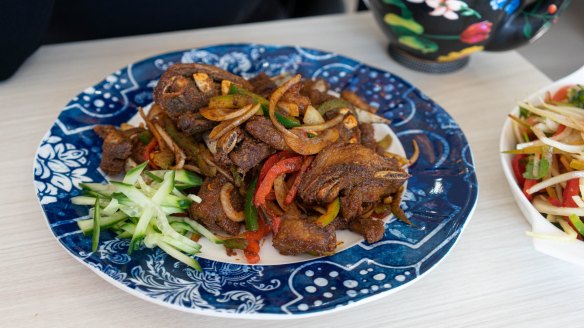
We walk around the corner to Dolan on Silk Road and order salted milk tea. Kaul developed a taste for Uighur food when she was 16, training with the Australian fencing team in China (an ankle injury cut her career short). One day, avoiding the Chinese characters for beef on the menu, she ordered da pan ji (big plate chicken) on a whim.
Back in Box Hill, we use our hands to eat lamb ribs tenderised with onion and dusted in cumin. Kaul tells me she took her family to Dolan's city branch for the first time, and her dad agreed it tasted like home.
For our final stop, Kaul leads me to a bland grey building covered in graffiti. The window decals have faded to blue and the place looks abandoned, but Wong's Lucky Bar is very much open.
Technically we are here for XO pipis – until Kaul spots mud crab at $21.80 a pound (0.45 kilograms). "Shall we just finish with crab? YOLO!"
Kaul does a quick calculation and sighs. The restaurant can't be making any money from the dish.
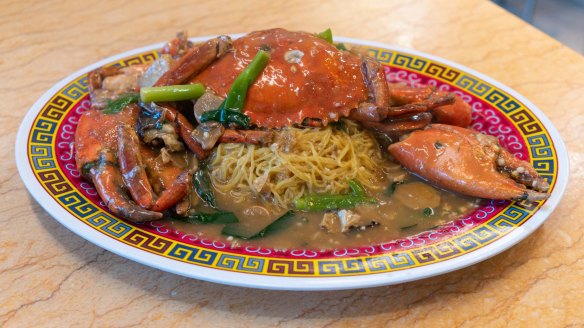
"As much as I appreciate being able to access food, because life is expensive, it usually means someone is sacrificing something somewhere," she says. "People want to be fawned over. They want an incredible selection of wines. They want all of their dietary requirements catered to on a 12-course tasting menu … and they're like, but crab only costs this, so why am I paying more? It's like you're not allowed to make money in food and I don't really know why that is."
Thinking back to our earlier visit to Blissful Station, she says: "Did you see the way that guy was rolling wontons before? For what, six for $5? It's nuts. That skill is worth everything."
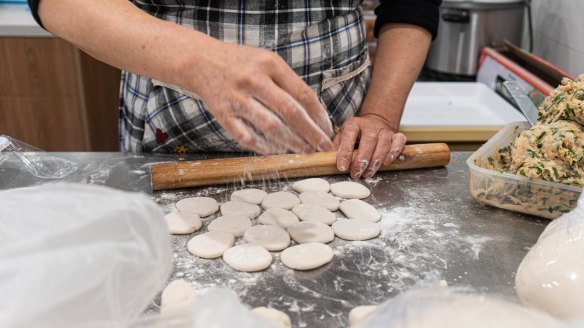
The details
- Ms Bean, Blissful Station, Rainbow Chicken, Grain Asian Cafe, Home Souv, Magic Cuisine, Colourful Yunnan – all at Box Hill Central, 1 Main Street
- Hills BBQ Noodle Shop, 586 Station Street
- Shaanxi-Style Restaurant, 943-945 Whitehorse Road
- Old Street Hunan, 566 Station Street
- Box Hill Asian Food Centre, 562 Station Street
- Victoria Quality Butcher, 592 Station Street
- Dolan on Silk Road, 968 Whitehorse Road
- Wong's Lucky Bar, 921 Whitehorse Road
Appears in these collections
Restaurant reviews, news and the hottest openings served to your inbox.
Sign up
